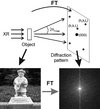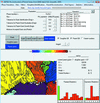issue contents
December 2007 issue

Cover illustration: Molecular electrostatic potential of thymidine mapped on the charge density isosurface at 0.5 e Å-3 using MolIso. Courtesy of C. B. Huebschle & P. Luger [J. Appl. Cryst. (2006), 39, 901-904].
research papers
The structures of ZnSe and CdSe/ZnS core/shell nanoparticle samples have been studied by analysing the radial distribution functions. Methods are presented to calculate the radial distribution functions of these nanoparticle types.
Identification of hetero-oligomeric proteins based on their amino acid sequence and implications for macromolecular crystallography are discussed.
A procedure for determination of dislocation density in weakly distorted crystals by means of X-ray extinction measurements is proposed.
The chemical reactions and transformations accompanying clinkerization have been followed in situ by X-ray synchrotron powder diffraction at temperatures between 1200 and 1700 K. All patterns have been evaluated by the Rietveld method to obtain quantitative phase analyses.
Dispersions of triglyceride nanocrystals exhibit complex small-angle X-ray diffraction patterns due to the occurrence of different structural features on similar length scales. A novel computer-aided data analysis method is introduced and applied successfully to SAXS patterns of phospholipid-stabilized tripalmitin nanosuspensions.
Applied to in-lab X-ray powder cell data for triclinic vanadate and arsenate apatites, a novel and simple method for the least-squares extraction of the thermal expansion tensor shows that both materials contract considerably along [2 4] upon heating. Reversible phase transitions observed at, respectively, 453 and 583 K are attributed to mobility of contact surfaces between triclinic twins within mosaic blocks.
4] upon heating. Reversible phase transitions observed at, respectively, 453 and 583 K are attributed to mobility of contact surfaces between triclinic twins within mosaic blocks.
Variations of lattice and modulation parameters of an incommensurately modulated phase as well as the resulting line broadening were theoretically analysed.
A simple and completely general phasing procedure (S-FFT) has been developed that maximizes the direct-methods origin-free modulus sum function S by means of the FFT algorithm. An algorithm combining the S-FFT procedure with real-space constraints according to the Shake-and-Bake philosophy is given and its capability to treat powder diffraction data is proved with some realistic test structures.
A structural study of α-AgSCN was carried out using the neutron powder diffractometer HIPPO (high-pressure preferred orientation powder) at ten different temperatures between 25 and 275 K. α-AgSCN is unusual in that it has an ordered structure with no disorder in the orientation of the anionic ligands.
A program for modelling intricate molecules based on refinement of internal coordinates is described.
The precise location of the intersection of the grating truncation rods with the Ewald sphere of a grating is calculated for any azimuthal angle by grazing-incidence small-angle X-ray scattering.
Monte Carlo simulations show that improved guide characteristics, a diverging trumpet at the beginning of the guide system and a converging guide at the end (maybe with a variable trumpet) promise a considerable improvement of the performance of D11 or other pinhole small-angle neutron scattering (SANS) instruments with the converging trumpet overcoming disadvantages for small collimation distances caused by the diverging trumpet. The use of a glass guide to reduce background is a good concept for SANS instruments.
This work demonstrates the very low Mo solubility in UAl3 and UAl4 binary phases; it contradicts the hypothesis of the formation of (U,Mo)Al3 and (U,Mo)Al4 often presented in the literature.
Download citation


Download citation


The biases in the structural analysis of light-induced molecular metastable states are quantitatively investigated using simulated and experimental data for the spin-crossover complex [Fe(phen)2(NCS)2].
The method of white-beam X-ray microdiffraction has been extended to obtain phase information from samples that exhibit a heterogeneous mineralogy. By indexation of the complex Laue patterns, demonstration of the white-beam methodology is applied to determine the mineralogy of colour pigments from an ancient Egyptian coffin.
Application of multivariate analysis to in situ X-ray diffraction data sets shows great promise for extraction of weak diffraction signals. The mathematical treatment of the data set enables separation into individual components, thus enabling a more straightforward investigation of dynamic reaction behavior.
An improved version of the microspectrophotometer of the ESRF `Cryobench' laboratory is described, and the implementation of a fluorescence lifetime measurement system suitable for crystals or nanolitre-sized solution samples is reported.
A Raman microspectrophotometer is described that allows the investigation of protein crystals under the same experimental conditions as those used for X-ray diffraction. Examples highlight the outstanding quality of Raman spectra recorded in protein crystals under non-resonant conditions, and demonstrate the interest of the technique as a complementary tool to macromolecular crystallography.
SAXS-based protein models can be obtained by conventional or ab initio approaches. The comparison of these models with those obtained from crystallography shows far-reaching agreement, even in the case of giant proteins.
Download citation


Download citation


Variable-temperature X-ray crystal structure determinations (80–330 K) on {Fe[tren(6-Mepy)3]}(ClO4)2 (1-Fe) and {Zn[tren(6-Mepy)3]}(ClO4)2 (1-Zn) were carried out together with a detailed analysis of the unit-cell volume and parameters in the spin transition region for (1-Fe). The variation in metal–ligand bond lengths, the distortion parameters, as well as the cell parameters are very close to the character of the magnetic curve and the curve of γHS derived from the Mössbauer data which shows the correlation between structure and physical properties in (1-Fe).
By a combination of synchrotron X-ray diffraction and optical studies, it is concluded that incorporation of nitrogen into natural diamond during growth stiffens the structure against plastic deformation.
teaching and education
Free 

Concepts such as Fourier transformation, convolution and resolution that are required to understand crystallography are illustrated through visual examples.
short communications
The crystal structure of a cubic  perovskite-type doped lanthanum cobaltite, La0.6Sr0.4CoO3−δ, has been studied using in situ neutron powder diffraction data measured at 1531 K.
perovskite-type doped lanthanum cobaltite, La0.6Sr0.4CoO3−δ, has been studied using in situ neutron powder diffraction data measured at 1531 K.
The application of the polycapillary X-ray optics in confocal three-dimensional energy-dispersive micro X-ray diffraction experiments is studied.
computer programs
A program for refinement of reflectivity data using a genetic algorithm, differential evolution, is presented. The program is capable of simulating diffuse and specular X-ray reflectivity, as well as neutron reflectivity with or without magnetic contrast including spin-flip scattering.
Open  access
access
 access
accessThis computer program calculates the orientational variants, the operators and the composition table of a groupoid.
Open  access
access
 access
accessA computer program has been written to reconstruct the parent grains from EBSD data of phase transition materials.


 journal menu
journal menu














































